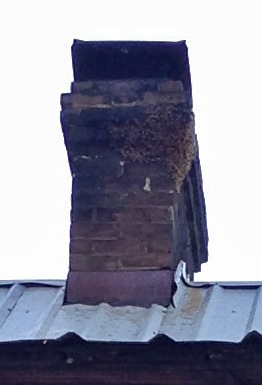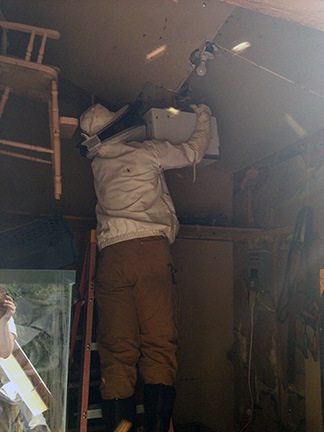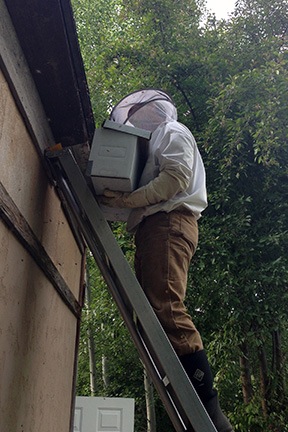I accompany friends while they track down three swarms of bees.

While I was admiring my new beehive, my friend James was on the phone, taking down information about two swarms he might be able to capture.
On the day I set up my hive in a friend’s yard, he got a call from a fellow beekeeper with two leads on swarms that needed capturing. Within 15 minutes, the two of us were heading north on highway 97 to chase them down.
About Bee Swarms
First, you need to understand that a bee swarm is not a dangerous thing. In fact, bees are least likely to bother people when they’re swarming because they don’t have a hive to protect. They’re on the go, looking for a new home. They’re protecting the queen. When they’re hanging out somewhere, they’re resting and waiting for scout bees to return with news about possible hive sites.
Beekeepers love swarms. Why? Well, because they’re free bees.
All a beekeeper needs to do is go to the swarm with a box and some protective gear, sweep the bees and their queen into the box, cover it up, and go. Back at the apiary, dump the bees into a hive body with frames and voila! A new colony, all set to grow and produce honey.
Or, if the beekeeper doesn’t need another colony, he can let the swarm develop into a colony in a nuc box and sell it to someone who needs bees.
Either way, it’s a win.
The Weeping Cherry Swarm
The first swarm sounded like the good one. It had landed in a weeping cherry tree at a home right off the main road. The tree was reportedly only 7 feet tall. That made it a potentially easy capture.
The only problem is, the call had come in earlier in the day. Much earlier.
We arrived at a nice home at the end of a dirt road. The Columbia River drifted past in the form of the Entiat Reservoir. There were lots of trees but no people. My friend, James, went to find the homeowners while I looked for a buzzing weeping cherry tree, not really knowing what such a tree looked like.
He called out to me a while later. He’d found the homeowner. The swarm had moved on a while before. We’d missed it.
The Chimney Swarm

I know this is a pretty crappy photo, but take my word for it: there’s a partial swarm of bees on this chimney.
The second swarm was reported up by 25-mile creek on Lake Chelan. A quick check of my map app told me it would take 40 minutes to get there. I called the homeowner while James drove.
The swarm had been inside their chimney. When they discovered the bees, the homeowners had lit a fire in the fireplace to get them out. They’d come out of the chimney and were now on the outside of it in a big mass.
It was a two-story log home.
We arrived after a nice drive through the mountains at a home high above Lake Chelan with magnificent views of the lake and the mountains beyond. We met the homeowners and they pointed out the bees. Sure enough, they were gathered on the side of the chimney, high above us.

Here’s James at the edge of the roof at the front of the house, trying to throw a rope over the peak.
The roof was steep and metal. James and the homeowner put an extension ladder in the back of the truck. James climbed up. He tried to throw a rope over the peak of the house so it could be held or tied on the opposite side to prevent him from falling off the roof when he climbed. There was no way he could climb to the bees without such protection.
Multiple tries from both sides of the house proved unsuccessful. By this time, James had gotten a good look at the bees and was quite certain that it was only part of the swarm and was likely queenless. Not very valuable and not likely to survive much longer.
James tried walking on the slick metal roof. He couldn’t get any traction. He told the homeowners that he was giving up. I thought it was a good idea. Climbing up that steep roof without a rope to support him would be a great way to get himself hurt or killed.
We left empty-handed again.
The Pump House Swarm
Fast-forward two days. The beekeeping group James and I belong to was meeting for their monthly “bee chat” in Leavenworth. One of the members, Steve, lived in Plain, about 16 miles away. He put out an open invitation for members to visit his apiary. James and I went — he on his motorcycle and me in my Jeep.
Steve’s got six hives and is having some trouble with them — mostly, a queen that has stopped laying. He paints his hive bodies in pretty pastel covers and they look nice in his yard, protected from deer and bears by an electric fence. We visited and he showed us some of his feeders and his solution for winter protection. I learned a lot.
He told us he was going to try to pick up a swarm on his way to Leavenworth and invited us to come along. We did. I was even ready to help if needed — I had my bee equipment in my Jeep after tending to my bees at James’s house earlier in the day.

Steve had to scoop bees out of a hole in the building’s ceiling.
The swarm was almost all the way back to Leavenworth. The homeowner met us as we pulled up in our three separate vehicles. The bees, he said, had been hanging around on the outside of the pump house. He pointed to a building near a creek on his property that had bees coming out of the eaves. They’d since moved inside.
Steve went in for a look. James and I peeked, too. There were bees all over the place, but mostly around a big hole in the building’s ceiling.
Steve suited up, grabbed a nuc box with a few frames in it, and went into the building with a ladder. A few minutes later, he was scooping bees out of the ceiling and into the box, hoping to get the queen among the handfuls of bees he moved.
We stayed outside the building. It seemed like the prudent thing to do.
When he was finished, he came outside for a break. He reported that there was something dead in the ceiling. The homeowner said it could be the squirrels who had lived in there and done all the damage.

It was easier to gather bees on the outside of the building.
James got a picking ladder and leaned it on the side of the building. Steve climbed up and started scooping bees from the outside of the building into the box. His goal was to get as many bees as he could.
He also examined the bees in the box to see if they were “fanning.” He explained that when the queen was captured, the other bees would use their wings to spread her scent out where the other bees could smell her. The idea was for everyone to come together where the queen was. He saw some evidence of fanning in thx box and none on the side of the building. That was a good thing.
After a while, he’d done just about all he could. He closed up the box, taped the lid down, and put it in the trunk of his car. As he stripped off his bee suit, he told the homeowner to call him if the bees were still there the next day. He’d come back and try to get the rest of them.
One for Three
The score for the three attempts I’d witnessed this past week was one for three. I don’t think it had anything to do with skill, though. I think it was luck. James had bad luck, Steve had slightly better luck.
In watching two successful swarm captures (including the one last year), I’m pretty confident that I could catch a swarm if it was easily accessible — maybe on a 7-foot weeping cherry tree. I hope to get the opportunity to try soon. Wish me luck!
Discover more from An Eclectic Mind
Subscribe to get the latest posts sent to your email.

I never thought beekeeping could be so interesting. How do you get reports on where the bee swarms are moving?
Because it’s widely known that bees are having some problems lately, when people find swarms in their yards they normally call the local animal control people. Those people have the phone numbers of local beekeepers.
For example, the guy who runs the club I belong to has his number out there for people to call. When he gets a swarm call, he calls the person in the club who lives closest to the swarm and tells them about it.
Although I’ve never caught a swarm, I believe I’m qualified to do so. I’ve seen it done twice and I have all the equipment. As long as the swarm isn’t too hard to reach, I really think I could capture it. I hope I get a chance to see if I’m right.
Fun and fascinating reading, Maria. This is a great adventure, and I’m happy to follow along via your writing. :-)
Maria,
What is so neat a swarm is the fact that they have ingested so much honey to carry it to the new hive that they are almost drunk…they would be hard pressed to have the ability to sting at that point!
If you ever have the opportunity to get close to a swarm – do so, you can move them around with your hands and look for the Queen… find her and put her in a box and the rest will follow you and her to their new home
Swarms are amazing — and so misunderstood by the general public. They’re really not dangerous unless you provoke them — and you’d have to really be working at it to get them angry enough to attack. In both successful captures I witnessed, once the queen was in the box, the job was 80% done. I really do hope I get a chance to try my hand it it this year; got that nuc box sitting around with 5 frames on it just in case I get a call.